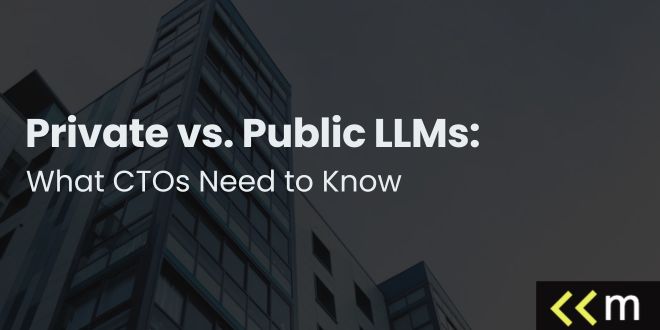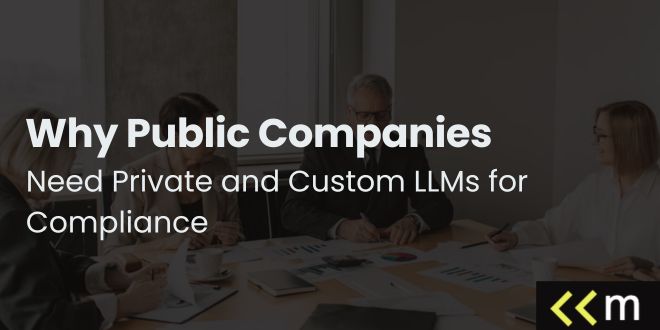Private vs. Public LLMs: What CTOs Need to Know

Every CTO wrestling with AI strategy has felt the ground shift underfoot since the first Large Language Model (LLM) captured mainstream attention. Suddenly, sales teams want chat-based assistants, analysts hope for automated insights, and customer-support leads dream of 24/7 bots that never tire.
The board, meanwhile, expects airtight security and cost transparency. That tension—ambition on one side, risk on the other—sits at the heart of one essential choice: Do you lean on a public, shared LLM or invest in a private, custom one? Below is a pragmatic look at that decision, tailored to the questions technical leaders face daily.
The Stakes for Modern CTOs
Short product cycles and the race for differentiation mean you can’t stall on generative-AI adoption. Yet sloppy moves around data residency, intellectual property (IP), or cost forecasting can torch trust in months. Choosing between public and private LLM infrastructure is therefore less about buzzwords and more about operational commitments you’ll live with for years.
Understanding the Landscape
Public LLMs: Shared Powerhouses
Public LLMs—think OpenAI’s GPT-4, Google’s Gemini, or Anthropic’s Claude—live in a vendor’s cloud, trained on enormous general-purpose corpora and exposed through an API. They offer:
- Immediate access to cutting-edge reasoning and language generation.
- No capital expenditure on GPUs or MLOps talent.
- Automatic upgrades as the vendor releases new model versions.
But you implicitly accept the provider’s policies, rate limits, and geographic hosting. Even with enterprise controls in public companies, your prompts and outputs transit vendor infrastructure, and fine-tuning options may be limited or expensive (and maybe even non-compliant).
Private LLMs: Custom Fortresses
A private model is one you host—either fully on-premises or inside your own cloud tenancy. You might train it from scratch, but more often you’ll start with an open-weights foundation model (e.g., Llama 3, Mistral) and fine-tune on proprietary data. What you gain:
- Complete control over data governance, access logs, and encryption.
- Flexibility to bolt on company-specific knowledge without handing it to a third party.
- Freedom to throttle, scale, or compress parameters to your exact latency and cost targets.
The flip side is heavy lifting: GPU clusters, inference optimization, prompt-evaluation pipelines, dedicated engineers, and a longer path to production.
Key Decision Axes for CTOs
Data Governance & Privacy
Regulatory pressure is rising—from GDPR to HIPAA to industry-specific regimes like FINRA. If your prompts or retrieved context include PII, medical records, or high-value IP, a public LLM requires airtight contractual guarantees and sometimes client-side encryption. Private deployments keep data inside your perimeter, enabling:
- Custom retention policies (delete cache after each request, archive with key rotation, or air-gap certain workloads).
- Internal auditing that aligns with ISO 27001 or SOC 2 frameworks.
- Easier mapping of data-flow diagrams for compliance filings.
That said, major vendors now offer “zero-retention” tiers. For moderately sensitive workloads, a well-negotiated public-cloud agreement can be enough, sparing you the Ops burden.
Performance, Fine-Tuning, and Product Fit
Natural-language tasks rarely sit still. A support bot may need company jargon tomorrow, legal disclaimers next week, and eight-language coverage by Q4. With public LLMs you rely on retrieval-augmented generation (RAG) layers: shove context into the prompt and hope the model pays attention. Private models let you iterate deeper—LoRA adapters, continual training, or mixture-of-experts routing—yielding smaller prompts, faster inference, and tighter alignment.
Yet public APIs have an innovation velocity individual companies can’t match. New reasoning tricks (function calling, vision-language fusion, tool use) appear overnight. If your roadmap demands those leaps, public models keep you on the cutting edge with zero re-engineering.
Total Cost of Ownership (TCO)
LLM math is never just token cost. You must budget for:
- Development talent (prompt engineers, infra devops, ML researchers).
- Compute (GPUs for training, inference, and redundancy).
- Monitoring (bias, toxicity, hallucination detection).
- Legal review (terms of service, data-processing addenda).
Public LLM pricing looks steep at high volume, but the line item is predictable. Private models shift spend from opex to capex—you pre-purchase hardware, but per-token cost can drop dramatically after you cross a usage threshold. Many CTOs run spreadsheets modeling token volume versus GPU amortization; the break-even often sits between 40 and 150 million tokens per month, depending on region and performance targets.
Hybrid Approaches & Emerging Patterns
Use Public for Creativity, Private for Sensitive Logic
A growing pattern is to split workloads: marketing copy, brainstorming, or code snippets flow through a public LLM, while customer PII or proprietary formulas stay local. Orchestrators like LangChain, LlamaIndex, and custom API gateways make it easy to route requests based on classification scores.
Bring-Your-Own-Key Encryption
Vendors now let enterprises bring customer-managed keys. You encrypt prompts client-side; the model decrypts inside an isolated enclave at inference and discards data afterward. This middle ground gives some of the privacy of private models without infrastructure overhead, though you still rely on vendor attestations.
Federated or On-Device Models for Edge Privacy
For chat in mobile apps or field-service tablets with spotty connectivity, CTOs experiment with 1-to-7-billion-parameter LLMs running on CPUs or smartphone NPUs. You avoid cloud latency and preserve privacy, while heavier tasks still fall back to a central model.
Practical Steps Toward an Informed Decision
- Inventory Your Data: Map out which data classes interact with the model: public marketing copy, semi-sensitive tickets, or crown-jewel source code. Sensitivity dictates hosting.
- Prototype Both Paths: Spin up a quick RAG pipeline on a public LLM and, in parallel, fine-tune an open-weights model in your sandbox. Compare latency, cost per call, hallucination rate, and engineering hours.
- Stress-Test Compliance: Invite your legal and security teams early. Can you satisfy right-to-erasure or data-sovereignty clauses with each approach? Log every roadblock.
- Model TCO Over 24 Months: Include GPU rentals, staff time, vendor support, and downtime risk. Factor in the probability you’ll need to retrain as new data arrives.
- Plan for Continuous Evaluation: Whether public or private, the model will drift. Establish human-in-the-loop review, automated red-teaming, and version-to-version regression tests.
When to Double-Down on a Private LLM
If your core competitive edge lives in proprietary text, code, or domain-specific reasoning—and data-sovereignty fines would dwarf infrastructure spend—a private LLM deployment is likely inevitable.
Companies in finance, defense, and healthcare already treat LLM stacks as they do databases: strategic assets, never outsourced in entirety.
In short, anyone looking to win the AI arms race should be investing their own data in a private large language model.
When a Public LLM is the Smarter Bet
Startups and fast-moving product teams often gain more from public models’ momentum than they lose in control. If you need time-to-market measured in weeks, not quarters, or you simply can’t attract ML infrastructure talent, renting brains from a vendor keeps you focused on user value rather than cluster maintenance.
Final Thoughts
The public-versus-private debate isn’t binary; it’s a sliding scale influenced by risk tolerance, budget, and product cadence. The role of the CTO is to treat Large Language Model strategy as a portfolio decision—mixing public APIs for raw creative power, private models for guarded knowledge, and edge deployments for offline resilience. Whatever blend you choose, bake governance and observability into the stack on day one.
The models will evolve, customer expectations will spike, and regulations will tighten, but a well-architected foundation keeps you nimble. In the end, the winners won’t merely be the firms with the biggest models; they’ll be the ones who aligned technical choices with business truths early—and kept revisiting those choices as the landscape shifted.
Samuel Edwards is an accomplished marketing leader serving as Chief Marketing Officer at LLM.co. With over nine years of experience as a digital marketing strategist and CMO, he brings deep expertise in organic and paid search marketing, data analytics, brand strategy, and performance-driven campaigns. At LLM.co, Samuel oversees all facets of marketing—including brand strategy, demand generation, digital advertising, SEO, content, and public relations. He builds and leads cross-functional teams to align product positioning with market demand, ensuring clear messaging and growth within AI-driven language model solutions. His approach combines technical rigor with creative storytelling to cultivate brand trust and accelerate pipeline velocity.







